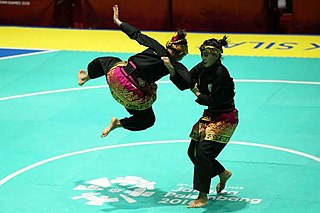Attributes of a pendekar
A pendekar must master every aspect of silat. These include the forms and techniques, their combat application, internal methods and traditional medicine. A pendekar must be more than an instructor or expert, they must be a fighter, a traditional doctor, and a participant in the culture and wisdom of silat. The emphasis given to each of these varies from one style to another. Some systems are more sport-oriented while others focus on spiritual development. Traditional masters only consider a style to be "true silat" if it can be used in battle.
Meditation and internal training serves as a counterbalance for a warrior's martial skills. In northern Malaysia and southern Thailand, this balance is symbolised by the concept of jantan betina (male-female), equivalent to the Chinese yin and yang. [3] In Indo-Malay folklore, esoteric knowledge is only gained by fasting and then meditating under a tree. Silat practitioners of the past would meditate and fast at length, often in caves, jungles and even graveyards so they would not fear death. With this mentality, a pendekar is always prepared for combat, whether they are unarmed or outnumbered. This is encapsulated in the Malay saying "From the tips of the hair to the tips of the toes" (Dari hujung rambut ke hujung kaki) meaning that all are potential weapons to be used at the right moment.
Purportedly, a pendekar of the highest skill needs no weapon aside from their mind to subdue the opponent. By focusing their energy, masters were said to be able to attack an opponent without physically touching them, strike a vital point from afar, or stop someone's heart without them noticing they've been hurt. Silat folklore is replete with tales of fighters possessing such skills as the ability to run very rapidly, vanish in a puff of smoke and reappear, change form, dash across the surface of water, turn invisible, or leap to the roof of a house.
Finally, a pendekar must be familiar with traditional healing methods. Massage is commonly taught alongside silat because of its relation to sentuhan or the art of striking pressure points. Sentuhan could also be applied to other aspects of healing such as stopping a wound from bleeding or stimulating energy flow. Some masters may have knowledge of herbalism or bone-setting. It was once considered necessary for anyone teaching silat to be able to nurse injured students back to health.

Martial arts are codified systems and traditions of combat practiced for a number of reasons such as self-defence; military and law enforcement applications; competition; physical, mental, and spiritual development; entertainment; and the preservation of a nation's intangible cultural heritage.

Arnis, also known as kali or eskrima/escrima, is the national martial art of the Philippines. These three terms are, sometimes, interchangeable in referring to traditional martial arts of the Philippines, which emphasize weapon-based fighting with sticks, knives, bladed weapons, and various improvised weapons, as well as "open hand" techniques without weapons.

Silat Melayu, also known as Seni Persilatan Melayu or simply Silat, is a combative art of self-defence from the Malay world, that employs langkah ('steps') and jurus ('movements') to ward off or to strike assaults, either with or without weapons. Silat traced its origin to the early days of Malay civilisation, and has since developed into a fine tradition of physical and spiritual training that embodies aspects of traditional Malay attire, performing art and adat. The philosophical foundation of modern Malay Silat is largely based on the Islamic spirituality. Its moves and shapes are rooted from the basis of Silat movements called Bunga Silat, and Silat performances are normally accompanied with Malay drum assembles.

Kuntao or kuntau is a Hokkien term for the martial arts of the Chinese community of Southeast Asia, specifically the Malay Archipelago. It is most commonly practiced in and associated with Indonesia, Malaysia, the Philippines and Singapore.

Japanese martial arts refers to the variety of martial arts native to the country of Japan. At least three Japanese terms are used interchangeably with the English phrase Japanese martial arts.

Kata is a Japanese word meaning "form". It refers to a detailed choreographed pattern of martial arts movements. It can also be reviewed within groups and in unison when training. It is practiced in Japanese martial arts as a way to memorize and perfect the movements being executed. Korean martial arts with Japanese influence use the derived term hyeong and also the term pumsae.

Pencak silat is an umbrella term for a class of related Indonesian martial arts. In neighbouring countries, the term usually refers to professional competitive silat. It is a full-body fighting form incorporating strikes, grappling, and throwing, in addition to weaponry. Every part of the body is used and subject to attack. Pencak silat was practiced not only for physical defense but also for psychological ends. There are hundreds of different pencak silat styles and schools which tend to focus either on strikes, joint manipulation, weaponry, or some combination thereof.
Indian martial arts refers to the fighting systems of the Indian subcontinent. A variety of terms are used for the English phrases "Indian martial arts", deriving from ancient sources. While they may seem to imply specific disciplines, by Classical times they were used generically for all fighting systems.
The Liu Seong System is one of the many styles of Kuntao, which are hybrid martial arts systems derived from the cultures of Chinese Indonesia. The Liu Seong system was brought to America, from Indonesia, by Willem A. Reeders (1917-1990).

Footwork is a martial arts and combat sports term for the general usage of the legs and feet in stand-up fighting. Footwork involves keeping balance, closing or furthering the distance, controlling spatial positioning, and/or creating additional momentum for strikes.

Seni Gayung Fatani is a martial art, specifically a style of silat from Malaysia based on the art of war, the combination punch and kick striking, joint-locking and grappling techniques, and various type of melee weapon. In Malay, the word seni means art and gayung is a word for martial arts, synonymous with silat. Fatani means wise in Arabic and was chosen in 1976 by the councils of Guru Tua. The first grandmaster of the silat is Tuan Guru Hj Anuar Abd. Wahab (1976–2009). The second grandmaster was Tuan Guru Aminuddin Haji Anuar (2009–2023) and the current grandmaster of Seni Gayung Fatani Malaysia is Grandmaster Mohd Safwan Abu Hassan.

Seni Gayong is a style of silat from Malaysia. It was the first martial arts association to be registered in the country, and is now the biggest and most internationally known Malaysian silat discipline. Gayong is overseen by the Pertubuhan Silat Seni Gayong Malaysia (PSSGM) or the Malaysian Silat Seni Gayong Organisation. This organisation is currently led by Dato' Ismail Jantan. While it is most popular in Malaysia and Singapore, there are also branches in Vietnam, Australia, France, Kuwait, Tunisia, Britain, and the United States.

Silat is the collective term for a class of indigenous martial arts from the Nusantara and surrounding geocultural areas of Southeast Asia. It is traditionally practised in Brunei, Indonesia, Malaysia, Singapore, Southern Thailand, Southern Philippines and Southern Vietnam. There are hundreds of different styles (aliran) and schools (perguruan) which tend to focus either on strikes, joint manipulation, weaponry, or some combination thereof.

Bakti Negara is a style of pencak silat from Bali. It is firmly rooted in old Balinese Hinduism and philosophies of Indonesia. The name means "national devotion", from the Sanskrit words bhakti (devotion) and nagara (country). It is the most widely practiced martial art in Bali and the most well-known style of Balinese silat, to the point that the system is commonly referred to simply as pencak Bali or kuntao Bali.
Silat Patani is a style of silat originating in the Pattani kingdom, now a state of Thailand. It is primarily practiced in northern Malaysia and southern Thailand. The art is also known as silat tua because tradition credits it as the oldest form of silat Melayu. It is sometimes called silat tua Yawi, being the Thai-Malay pronunciation of Jawi in this case referring to the Thai Malay community. These two latter names are increasingly popular among Malaysian practitioners, so as not to acknowledge the Pattani origin of the art.

Listed here are the weapons of pencak silat. The most common are the machete, staff, kris, sickle, spear, and kerambit. Because Southeast Asian society was traditionally based around agriculture, many of these weapons were originally farming tools.
Lian Padukan is an offensive martial art that specialises in close-range striking. It is one of Malaysia's biggest silat schools and also the most well-known variant of lian or buah pukul. Because of their shared Yunnan origin, lian padukan is very similar to Chinese Wing Chun.

Angampora is a Sinhalese martial art that combines combat techniques, self-defense, sport, exercise, and meditation. A key component of angampora is the namesake angam, which incorporates hand-to-hand fighting, and illangam, involving the use of indigenous weapons such as the ethunu kaduwa, staves, knives and swords. Another component known as maya angam, which uses spells and incantations for combat, is also said to have existed. Angampora's distinct feature lies in the use of pressure point attacks to inflict pain or permanently paralyze the opponent. Fighters usually make use of both striking and grappling techniques, and fight until the opponent is caught in a submission lock that they cannot escape. Usage of weapons is discretionary. Perimeters of fighting are defined in advance, and in some of the cases is a pit.

Indonesian martial arts includes a variety of fighting systems native to or developed in the archipelago of Indonesia, both the age-old traditional arts, and the more recently developed hybrid combatives. In the Indonesian language the term bela-diri is used to mean martial art, and in essence the Indonesian fighting arts are meant as one's defence against perceived threat and assault. Other than physical training, they often include spiritual aspects to cultivate inner strength, inner peace and higher psychological ends.

Pencak Silat Harimau also known as Silat Harimau is a Minangkabau style of pencak silat originating from West Sumatra, Indonesia. Silat Harimau has movements that are used to resemble the technique and philosophy of a tiger. Silat harimau has agile techniques and beautiful movements. However, behind these techniques and movements, there are various deadly attacks that are applied to immobilize the enemy very quickly.
















